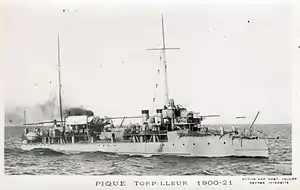Framée-class destroyer
The Framée class consisted of four destroyers built for the French Navy at the beginning of the 20th century. One ship was sunk in a collision shortly after completion, but the others served during the First World War. One ship was sunk in a collision with a British cargo ship in 1916, but the others survived the war to be discarded in 1920–1921.
 | |
| Class overview | |
|---|---|
| Name: | Framée class |
| Operators: |
|
| Preceded by: | Durandal class |
| Succeeded by: | Rochefortais class |
| Built: | 1897–1901 |
| In service: | 1900–1921 |
| Completed: | 4 |
| Lost: | 2 |
| Scrapped: | 2 |
| General characteristics | |
| Type: | Destroyer |
| Displacement: | 319 t (314 long tons) |
| Length: | 58.2 m (190 ft 11 in) o/a |
| Beam: | 6.31 m (20 ft 8 in) |
| Draft: | 3.03 m (9 ft 11 in) |
| Installed power: |
|
| Propulsion: | 2 shafts; 2 triple-expansion steam engines |
| Speed: | 26 knots (48 km/h; 30 mph) |
| Range: | 2,055 nmi (3,806 km; 2,365 mi) at 10 knots (19 km/h; 12 mph) |
| Complement: | 48 |
| Armament: |
|
Design and description
The Framées had an overall length of 58.2 meters (190 ft 11 in), a beam of 6.31 meters (20 ft 8 in), and a maximum draft of 3.03 meters (9 ft 11 in). They displaced 319 metric tons (314 long tons) at deep load. The two triple-expansion steam engines, each driving one propeller shaft, produced a total of 4,200–5,200 indicated horsepower (3,132–3,878 kW), using steam provided by four water-tube boilers which exhausted through four funnels. The ships had a designed speed of 26 knots (48 km/h; 30 mph), but they reached 25.88–27.07 knots (47.93–50.13 km/h; 29.78–31.15 mph) during their sea trials.[1] The ships carried up to 99 metric tons (97 long tons) of coal[2] to give them a range of 2,055 nautical miles (3,806 km; 2,365 mi) at 10 knots (19 km/h; 12 mph). Their complement consisted of four officers and forty-four enlisted men.[1]
The Framée-class ships were armed with a single 65-millimeter (2.6 in) gun forward of the bridge and six 47-millimeter (1.9 in) Hotchkiss guns, three on each broadside. They were fitted with two single 381-millimeter (15 in) torpedo tubes, one between the funnels and the other on the stern.[2] Two reload torpedoes were also carried.[3]
Ships
| Name | Builder | Launched | In Service | Fate |
|---|---|---|---|---|
| Framée | Ateliers et Chantiers de la Loire, Nantes | October 21, 1899 | June 20, 1900 | Sunk August 11, 1900 |
| Yatagan | July 20, 1900 | October 1900 | Sunk November 3, 1916 | |
| Pique | Forges et Chantiers de la Méditerranée Le Havre | March 31, 1900 | June 1901 | Struck January 28, 1921 Scrapped, 1921 |
| Épée | July 27, 1900 | August 1901 | Struck October 1, 1920 Scrapped, 1921 |
Citations
- Couhat, p. 83
- Chesneau & Kolesnik, p. 326
- Couhat, p. 81
Bibliography
- Chesneau, Roger & Kolesnik, Eugene M. (1979). Conway's All The World's Fighting Ships 1860–1905. London: Conway Maritime Press. ISBN 0-85177-133-5.
- Couhat, Jean Labayle (1974). French Warships of World War I. London: Ian Allan. ISBN 0-7110-0445-5.
- Gardiner, Robert & Gray, Randal (1985). Conway's All The World's Fighting Ships 1906–1921. London: Conway Maritime Press. ISBN 0-85177-245-5.
- Osborne, Eric W. (2005). Destroyers - An Illustrated History of Their Impact. Santa Barbara, California: ABC-Clio. ISBN 1-85109-479-2.
External links
| Wikimedia Commons has media related to Framée-class destroyer. |